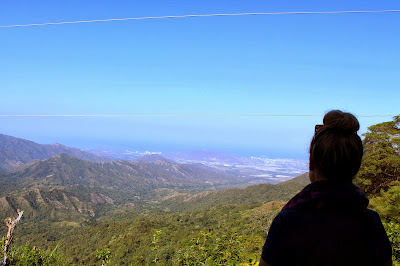“Why would they do this to us?!?” I yelled back to Gabe. “SERIOUSLY!
I can’t do this anymore!” I whined.
We were about an hour in to what
we were told would be a 45 minute hike, after the mule that was supposed to meet us never arrived, to reach La Finca Candelaria, a working
coffee farm and our accommodation for the next couple of nights. We were supposed
to be heading up to the mountain side town of Minca to decompress and chill for
a couple of days. Some chilling this is!!
We were both dripping sweat and
covered in dirt as we attempted to reach La Candelaria, a steep 400 meter continual
ascencion into the Sierra Nevada Mountains
in 100 degree heat with ALL of our possessions strapped to our backs and
fronts.
 |
| Finally at the top |
After another 45 minutes, we
finally reached the sign reading La Candelaria. After another 15 minutes uphill on the property, we
finally decided to leave our large backpacks on the ground and come back for
them later. Not since my college preseason 2-3-a-days have I been that
exhausted!! FINALLY, we reached the top of
our climb and arrived!
After a refreshing limonada(lime,
water and sugar drink), we went back and retrieved our bags. That is when the
nightmare ended and our vision of Minca started. We watched a beautiful sunset
and ate a delicious, home-cooked dinner by Ana, one of the owners.
Being that this is a working
coffee farm, we awake early to a crowing rooster. After another delicious home-cooked
meal and some fresh, organic coffee, we set out with Eugenio(the other owner)
and Soleil and Fernando(a lovely Aussie couple volunteering there) to learn
about the entire coffee making process.
 |
| Coffee Picking |
We picked coffee cherries off the
trees growing in the mountains, gathered them in our buckets and headed back to
the farm. From there we put the cherries into a machine which separates the
skin from the bean. From there, the beans were washed, sorted according to
quality, dried, sifted and finally we removed any “bad” beans. Then the boys
took turns roasting the coffee beans. Since we like our coffee strong(like our
drinks) we opted for a dark roast. After the coffee beans cooled, they were
ready to be ground.
 |
| Eugenio Sifting the Coffee Beans |
 |
| Dark Roast Coffee |
 |
| Grinding the Beans |
 |
| Sunset from the Finca La Candelaria |
The next couple of days were
spent getting back to basics. We enjoyed our home-cooked meals, freshly prepared
coffees, good books, great company and AMAZING mountain sunsets. Our stay as
the first guests, not volunteers, was perfect. It was the authentic Colombia
experience we have been craving.
 |
| Thanks Eugenio, Ana and Luna |
After all of the relaxing, it was
time to head back to Santa Marta for the New Year…but not before hiking back
down that mountain that nearly killed us the first time! Going down was much
easier, and only took us an hour from start to finish. Our resolution for this
New Year, get rid of some of our
**Travel tip: to get to Minca, you
need to go to the market on Calle 11/Cra. 12, to catch a rideshare in an old
car or jeep. It will cost 7,000CP per person and will not leave until there are
4 people. Since we were staying closer to Minca, we thought we could catch a collective
to Minca and avoid backtracking. No such collective exists. We ended up having
to hail a taxi halfway to Minca for $30,000CP.**






.JPG)





.JPG)

.JPG)
.JPG)
.JPG)



